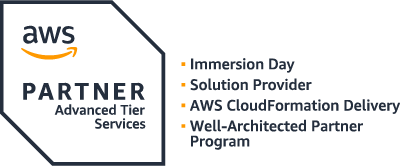Transform Your Business in the Cloud
Fundamentally transform your applications, infrastructure, and business with AWS.
Successful transformations start with clear expectations and participative planning. Our roadmapping service helps you identify stakeholders across your business, set a strategic future vision, and break down complexities into measurable, iterative milestones. We follow a time-proven process that produces adaptive results.

Pillars of Transformation
Fundamental Alteration
Intrinsically transform your business capabilities, processes, and relationships through innovative cloud technology.
Co-creation and Collaboration
Successful transformations start with clear expectations and participative planning. Our roadmapping service helps you identify stakeholders across your business, set a strategic future vision, and break down complexities into measurable, iterative milestones. We follow a time-proven process that produces adaptive results.
Governance
Adopting new technologies, business models, and ways of working raises challenges and opportunities that require a shared vision across the organization. Effective oversight practices regarding digital standards and policies, prioritization among competing interests, resource optimization, and compliance are essential.
Iterative & Data-Driven
Learn, build, measure. Repeat. In an ever-changing business environment planning and building iteratively based on measurable data insights in short cycle times enables businesses to stay ahead of the competition. Leverage the core principles of an agile mindset to unleash the power of AWS.
Talk to an AWS Consultant
Tell us a little about your business and its challenges, and we’ll see how we can help.
The 5 Pillars of the AWS Well-Architected Framework
The AWS Well-Architected Framework helps you understand the pros and cons of decisions you make while building systems on AWS. By utilizing the Framework we apply architectural best practices for designing and operating reliable, secure, efficient, and cost-effective systems in the cloud. It provides a schema to consistently measure your architectures against best practices and identify areas for improvement. The process for reviewing an architecture is a constructive conversation about architectural decisions and is not an audit mechanism. We believe that having well-architected systems greatly increases the likelihood of business success.
Operational Excellence
Support development and run workloads effectively, gain insight into their operations, and continuously improve supporting processes and procedures to deliver business value.
Design Principles
- Implement a strong identity foundation
- Enable traceability
- Apply security best practices
- Protect data in transit and at rest
- Prepare for security
Best Practices
Before you architect any system, you need to put in place practices that influence security. You will want to control who can do what. You also want to be able to identify security incidents, protect your systems and services, and maintain the confidentiality and integrity of data through data protection.
Security
Protect data, systems, and assets to take advantage of cloud technologies to improve your security.
Design Principles
- Implement a strong identity foundation
- Enable traceability
- Apply security at all layers
- Automate security best practices
- Protect data in transit and at rest
- Prepare for security events
Best Practices
Before you architect any system, you need to put in place practices that influence security. You will want to control who can do what. In addition, you want to be able to identify security incidents, protect your systems and services, and maintain the confidentiality and integrity of data through data protection.
Reliability
Ensure the ability of a workload performs its intended function correctly and consistently. This includes the ability to operate and test the workload through its total life-cycle.
Design Principles
- Test recovery procedures
- Automatically recover from failure
- Scale horizontally to increase aggregate system availability
- Stop guessing capacity
- Manage change in automation
Best Practices
Before architecting any system, foundational requirements that influence reliability should be in place. For example, you must have sufficient network bandwidth to your data center. These requirements are sometimes neglected (because they are beyond a single project’s scope). This neglect can have a significant impact on the ability to deliver a reliable system. In an on-premises environment, these requirements can cause long lead times due to dependencies and therefore, must be incorporated during initial planning.
Performance Efficiency
Use computing resources efficiently to meet system requirements and maintain efficiency as demand changes and technologies evolve.
Design Principles
- Democratize advanced technologies
- Go global in minutes
- Use serverless architectures
- Experiment more often
- Mechanical sympathy
Best Practices
Take a data-driven approach to selecting a high-performance architecture. Gather data on all aspects of the architecture, from the high-level design to the selection and configuration of resource types.
By reviewing your choices on a cyclical basis, you will ensure you are taking advantage of the continually evolving AWS cloud. Monitoring will ensure you are aware of any deviance from expected performance and can take action on it.
Cost Optimization
Run systems to deliver business value at the lowest price point.
Design Principles
- Adopt a consumption model
- Measure overall efficiency
- Stop spending money on data center operations
- Analyze and attribute expenditure
- Use managed services to reduce cost of ownership
Best Practices
As with the other pillars, there are tradeoffs to consider. For example, do you want to optimize for speed to market or for cost? In some cases, it’s best to optimize for speed—going to market quickly, shipping new features, or simply meeting a deadline—rather than investing in upfront cost optimization.
Design decisions are sometimes guided by haste as opposed to empirical data, as the temptation always exists to overcompensate “just in case” rather than spend time benchmarking for the most cost-optimal deployment. This often leads to drastically over-provisioned and under-optimized deployments.